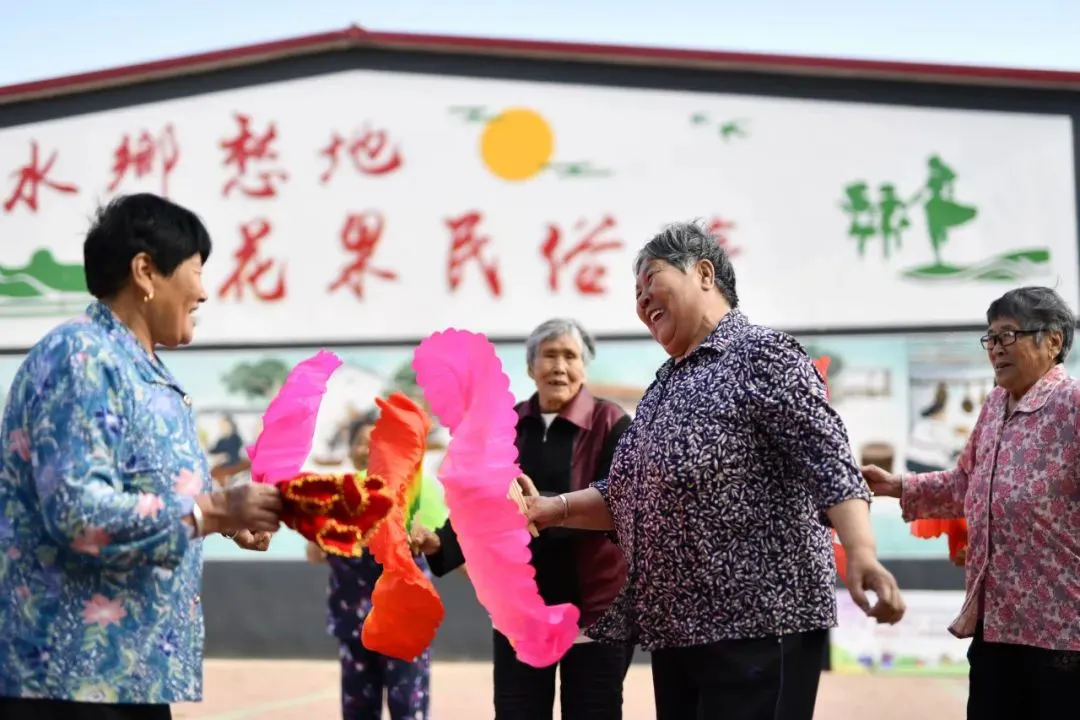A new chapter in rural elderly care:Explore diversified service models from families to communities
_ _
* This article is the content of the 13th issue of Banyuetan in 2024

七普数据显示,居住在乡村的老年人(60岁以上)共有1.2亿。作为一个以亿计的群体,农村老人的收入、消费水平、人均享有公共服务资源处于社会整体水平之下,农村养老服务是民生保障中的薄弱一环。2024年6月,中国首份全国层面发展农村养老服务的总体性部署出台,涉及部门达22个。民政部养老服务司有关负责人认为,当前城乡老龄化差距正在不断拉大,农村老龄化程度更高、形势更紧迫。 
From "mainly relying on family"
to "home-based"

In 1996, the Law on the Protection of the Rights and Interests of the Elderly was promulgated, stipulating that "the elderly mainly rely on the family for their elderly care, and family members should care about and take care of the elderly." In 2018, the law was revised for the third time, and the relevant expression was adjusted to "elderly care is based on home, and family members should respect, care for and care for the elderly." The words and words reflect the inheritance and development of the Chinese nation's virtues of respecting and assisting the elderly, and also reflect the quiet changes in the way of providing for the elderly under the wave of modernization.
Since the reform and opening up, economic and social development has made great strides forward, and the urbanization process and population mobility have accelerated. At the same time, many elderly rural people who are empty nests, live alone, and are still elderly. In real situations such as intergenerational separation of families, the family elderly care model in which children provide care has encountered an impact.
Experts such as Lu Jiehua, a professor at the Department of Sociology at Peking University, believe that since the 21st century, the public has gradually realized the need to provide institutional protection for rural elderly care services. Around 2012, the construction of the rural elderly care system entered a stage of advancement and shaping.

In 2011, the State Council issued the "Social Elderly Care Service System Construction Plan", which first mentioned "New Rural Mutual Assistance Elderly Care". In 2013, the Ministry of Civil Affairs issued the "Measures for Licensing the Establishment of Elderly Care Institutions". In 2015, the General Office of the CPC Central Committee and the General Office of the CPC Central Committee proposed to speed up the pilot project of elderly care in rural communities. Make full use of government, village collectives, social organizations and other resources to promote mutual assistance and community elderly care in rural areas. Exploration and pilot projects have been carried out across the country and are welcomed.
The rural elderly care service model has become increasingly socialized, diversified and standardized, and has also begun to connect with people's livelihood factors and development factors. In 2015, the State Council proposed to build an integrated medical and nursing system covering urban and rural areas. This year, the State Council's relevant documents on developing the silver economy specifically proposed to explore multiple business models and develop rural characteristic elderly care industries such as rural residence.
Optimizing rural elderly care requires real investment in social protection. In 2009, the State Council launched a pilot program for new rural social pension insurance, clarified the principles of financial investment, and changed the past "old farmers 'insurance" model that relied on farmers' self-savings to accumulate. In 2014, the "New Rural Insurance" and urban residents 'pension insurance were merged into basic pension insurance for urban and rural residents, and the social security system became more inclusive and fair.
In recent years, the trend of population aging has accelerated, and the phenomenon of rural population aging has become more prominent. In 2019, the Central Committee of the Communist Party of China and the State Council issued the "National Medium and Long-term Plan for Actively Responding to Population Aging", proposing to build a elderly care service system with complete functions, moderate scale, covering urban and rural areas, and combining medical care. In 2021, the "Opinions of the Central Committee of the Communist Party of China and the State Council on Strengthening Aging Work in the New Era" proposed to combine the implementation of the rural revitalization strategy to develop mutual assistance elderly care services and put forward specific requirements for the construction of rural elderly care service facilities.
"Poor demand" and "poor utilization" coexist

Handan, Hebei Province, explores the establishment of rural mutual aid and happiness homes with centralized living and mutual aid services; Xinyu, Jiangxi Province, covers meal assistance to every administrative village; Miyun, Beijing, hires villagers as neighborhood mutual aid workers and uses their residences as neighborhood mutual aid points... Grassroots in various places promote the initiative, explore rural elderly care models based on local realities, and achieve certain results.
But overall, rural elderly care is not optimistic. As elderly care service resources sink into rural areas, some service operators have found that the cost of serving the elderly in rural areas is higher."In cities, you can cut hair for 8 elderly people in one day, but in rural areas it is difficult to achieve even half of it." The person in charge of the civil affairs department of a county in Hunan believes that rural areas are large, the population is scattered, and limited resources are difficult to cover. This is the main difficulty for rural elderly care.
Compared with cities, rural elderly people have a higher degree of disability and heavy care burden. The Chinese Social Science Survey Center of Peking University found that the disability rate of elderly people in rural areas is 7 to 14 percentage points higher than that in urban areas, and the older the age, the wider the gap. At the same time, the rural elderly have a low level of social protection and weak purchasing power. The relevant person in charge of the Civil Affairs Bureau of Changxing County, Zhejiang Province said:"Rural elderly people are very sensitive to prices. The cost of each meal in a township elderly canteen is increased by an average of 1 yuan, and the number of elderly people eating is reduced by 23%."
Purchasing power is weak and supply is difficult. Experts believe that this gives rise to the problem of "poor demand" and "poor utilization", that is, the demand for some rural elderly care services cannot be met, and the supply of some services is relatively excessive. He Wenjiong, director of the Center for Aging and Health Research at Zhejiang University, said that some places emphasize the development of institutional elderly care, but currently the vacancy rate of beds in some institutions exceeds 50%. In the field of home-based elderly care, door-to-door medical, care, and psychological services for the elderly are relatively lacking.
Relevant research from the China Social Science Survey Center of Peking University shows that in the past, some local governments used the "supply-side" subsidy method to provide financial subsidies for elderly care services, that is, mainly subsidizing construction fees and operating expenses based on the number of beds, thus promoting the expansion of elderly care institutions. However, most elderly care institutions are set up in cities and towns, which virtually exacerbates the problem of unbalanced urban and rural elderly care resources and mismatch between rural elderly care supply and demand.
Regarding the exploration of rural mutual assistance elderly care such as volunteer services, low-payment services and "time banks" carried out in some areas, He Xuefeng, a professor at the School of Social Sciences of Wuhan University, believes that the current mutual assistance elderly care model relies on the social capital of the village, resulting in different development results and results in different regions. Taking "time banking" as an example, he believes that "the deferred payment method of intergenerational relay of labor results is not easy to be trusted and recognized", and it is difficult to accurately measure and circulate labor time, making the long-term operation of this mutual assistance model highly uncertain.
 农村居家养老托起“夕阳红” 牟宇 摄
农村居家养老托起“夕阳红” 牟宇 摄
Face up to the "shortcomings among shortcomings"

According to the data from the fifth sample survey on the living conditions of urban and rural elderly in China in 2021, rural elderly people are more severe than urban areas in terms of age structure, empty nest rate, health status and other indicators, and have a large gap between them and cities in terms of economic income level and affordability of elderly care service fees.
Doing a good job in rural elderly care services is not simply a matter of how much resources are invested. It involves structural factors such as unbalanced urban and rural development, still imperfect social protection systems, and changes in social and cultural concepts. It is a "tough nut" in the reform process. It is also a "shortcoming among shortcomings" in the field of people's livelihood security. To find a response strategy, we cannot do it piecemeal and add a few beds and put in a few equipment to the grassroots level. Instead, we must follow the principle of system coordination to form a joint force for reform.
In June 2024, the Ministry of Civil Affairs, in conjunction with 21 other departments, issued the "Guiding Opinions on Accelerating the Development of Rural Elderly Care Services"(hereinafter referred to as the "Opinions"), covering spiritual civilization, rural revitalization, education, justice, finance, health, emergency response, Natural resources and other fields. This is China's first overall deployment for the development of rural elderly care services at the national level.
The "Opinions" pointed out that the construction of rural elderly care service networks should be promoted from the county, township and village levels:Expand the functions of county-level support service institutions for extremely poor people, promote the construction of township (sub-district) regional elderly care service centers, and increase village-level elderly care service points; establish visits, care and emergency rescue for rural left-behind, elderly, disabled, and severely disabled elderly groups. Service mechanism; Improve the financing and benefit adjustment mechanism for basic pension insurance for urban and rural residents... In summary, the "Opinions" respond in a targeted manner to various difficult issues in the current rural elderly care, and at the same time follow the principle of preventing rural elderly people from leaving the village or leaving their homes to support the elderly. Work ideas and principles.
Excavate the endogenous motivation of rural elderly care

Is elderly care in rural areas necessarily inferior to urban areas? It is not difficult to see that many rural elderly people whose children settle down in cities have the conditions to leave their hometown to support the elderly, but they are still willing to spend the rest of their lives in the countryside. For the elderly, rural areas are close to nature and familiar with the land. They have both environmental conditions for home-based elderly care and endogenous motivation for mutual assistance in elderly care. In rural areas, there is also land that the elderly attach great importance to, which not only provides an irreplaceable sense of belonging, but also provides a sense of fulfillment and value that they can continue to engage in some easy agricultural production.
In the process of promoting rural elderly care services, we need to realize that the elderly are not only the objects of service supply and care security, but also the main body of rural construction and public services. Experts such as He Xuefeng believe that elderly care activities are "not only consumptive, but also productive." It is necessary to encourage rural elderly people to participate in various forms of social construction so that they feel respected and needed.
The relevant person in charge of the Elderly Care Services Department of the Ministry of Civil Affairs also believes that it is necessary to enhance the endogenous driving force for the development of rural elderly care services, give full play to the advantages of "close neighbors" and "acquaintances", and promote the combination of providing support for the elderly and providing something for the elderly. While doing a good job in service supply and improving the social protection system, it is particularly necessary to cultivate rural civilization, abandon age discrimination and negative attitudes towards the elderly, and rely on platforms such as the New Era Civilization Practice Station to create a cultural atmosphere of mutual assistance, friendship, respect and assistance for the elderly.
At the same time, more young and middle-aged groups can be encouraged to participate in rural elderly care services on the basis of urban and rural coordination. Mining the material reserves and health management needs of "preparing for old age" will enable young and middle-aged groups to have good expectations for elderly care in rural areas, and make rural areas with complete facilities, accessible services, and suitable for living and working a preferred option for elderly care.
半月谈记者: 孙文豪 责编:秦黛新 / 校对:褚孝鹏 
The label cannot be clicked during preview







